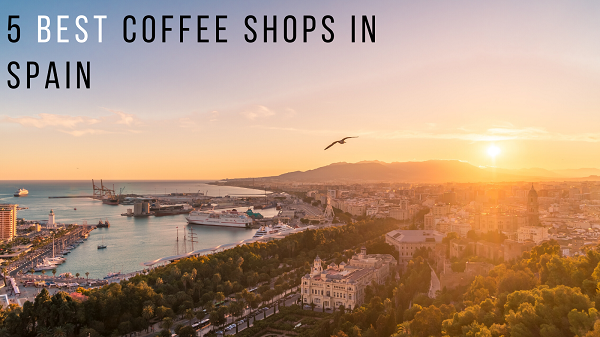5 of the Best Coffee Shops in Spain
Drinking coffee is a habit (and pleasure) that is taken quite seriously in Spain. Admit that you might occasionally drink a cup of instant coffee and face the risk of horrified stares and pariah status next time your friends or colleagues head to the local coffee shop for a break. Okay, maybe not that serious, but coffee tastes in Spain have been ground by decades of social and cultural tradition.
Whether it’s a small “hole-in-the-wall” café in a back alleyway, or a major coffee shop chain on the high street, the ingredients, preparation and blend have to be spot on.
1. Café Central (Malaga)
Image Source Visit Costa Del Sol
In the mid-1950s, when raw materials were rationed following the Spanish Civil War and coffee was especially expensive, the iconic Café Central Málaga created its own terminology to enable clients to specify exactly how they wanted their coffee, and produced a guide to that effect.
Today, the café’s wall is still adorned with a poster (albeit more sophisticated) featuring diagrammed illustrations of coffee cups explaining what each type entails – and other local establishments have followed its lead.
Such names and types tend to vary from region to region, and even city to town within the same region; but a waiter in Madrid, for example, will usually understand what you mean if you ask for your usual coffee type from Málaga.
Nevertheless, this classic original Café Central list is a useful guide to help Spanish coffee novices know what to order anywhere in Spain.
• Solo: Black, no milk, for “true coffee aficionados wanting to savour its full body”.
• Largo: large dose of coffee with a tiny addition of milk, “for when you become a little sleepy”.
• Semilargo: Slightly less coffee, with milk added.
• Solo corto: Black, only coffee, but less quantity than for a solo.
• MItad: Half coffee, half milk, “ideal for breakfast”.
• Entre corto: Halfway between a mitad and corto, for “experts”.
• Corto: More milk than coffee, “great for a mid-morning break”.
• Sombra: Even less coffee, filled up with milk, “for those who don’t want to abuse this natural stimulant”.
• Nube: Cup of milk with tiny amount of coffee, “to add a little colour and taste to the milk”.
So, now armed with invaluable knowledge about coffee types, and after starting our journey at Café Central Málaga, where should you also be heading to enjoy a notable coffee-drinking experience? Where are the best coffee shops in Spain? Here we discover four others...
2. Café Sierra de Alicante (Busot)
Image Source Business Broker Spain
In the village of Busot, around 20 kilometres from Alicante city, the Café Sierra de Alicante (located in the boutique hotel of the same name) offers clients “the fragrances of aromatic plants mixed with the smell of coffee of the highest quality and the sweet allure of fresh baked biscuits… a place to awaken the senses”.
Coffee is the ”hero”, with a wide variety on offer, but your steaming drink will always taste even better when accompanied by one of the coffee shop’s international pastries, including: sachertorte (Austria), rüblikuchen (Germany) jam roly-poly (England), French crêpes, Belgian waffles, Italian panna cotta and Dutch pancakes.
3. Bihotz Café (Bilbao)
Image Source Hotels
Located in the Muella de Marzana wharf area near the old town, popularly known as “Bilbao’s Soho”, the Bihotz Café is perhaps most celebrated for its craft beers on tap.
However, within its intimate surroundings, highlighted by a “hipster” décor blending Nordic, industrial and vintage styles and incorporating cosy seating, clients can also enjoy a menu of coffees that is chosen meticulously and changed periodically. In addition, they have a varied selection of teas, and in summer you can savour their refreshing “cold brew” coffee.
4. Culture Coffee (León)
Image Source Languedok
Described by one enthusiastic fan as “the El Bulli of coffee shops”, Culture Coffee can be found near the Ordoño area of León. As befits its chic setting and surroundings, the café’s coffees are produced using sustainably grown beans and environmentally sound practices and processes.
With a final flourish, the barista will even add a little decorative feature on top, which you can admire before getting down to the important business of drinking the richly aromatic brew.
5. Café Gijón (Madrid)
Finally to, arguably, Spain’s most famous café… The Café Gijón in the heart of Madrid (Paseo de Recoletos) was established in 1888 and – following the Civil War – it became a popular meeting place for writers, artists and intellectuals who belonged to the “Generation of ‘38” collective.
Over the years it has also attracted international stars including Truman Capote, Ava Gardner and Orson Welles, providing an invigorating social-cultural hub where clients can savour its venerable history while sipping on an exquisite cup of coffee.
Thanks to Dakota Murphy for the piece! Contact her on Twitter and LinkedIn









